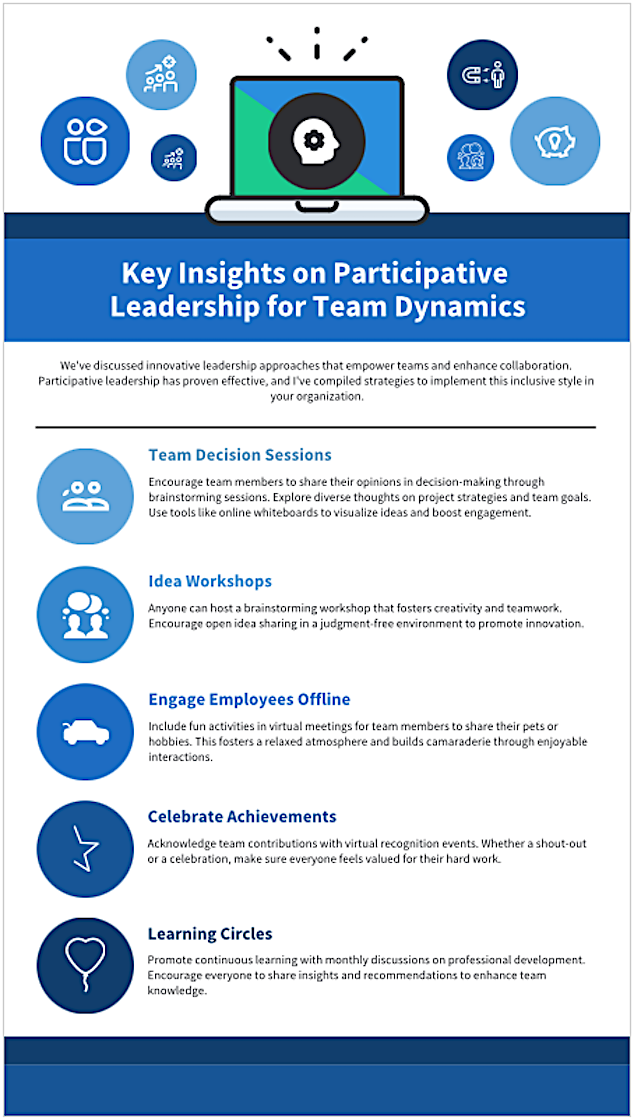There are many different kinds of leadership, and the style you choose could increase your chances of success. Research shows that participative leadership is usually more productive than authoritative models.
Tired of reading? Listen to our deep dive podcast on this article.
What is participative leadership?
It’s a form of governance that shares power and encourages input. Management studies show that it can enhance outcomes and increase job satisfaction and morale. It’s the difference between giving orders and building consensus.
For example, consider two different approaches to an office move. The CEO of a more autocratic company might pick the new location and give employees a list of tasks to complete.
On the other hand, a participative leader would form a committee to review possible sites and give employees the opportunity to discuss the final candidates and coordinate logistics.

Participative Leadership – JB Coaches 2024
Learning to be a more collaborative leader can help your relationships and your career. Put these suggestions to work for you.
Maximizing the Advantages of Participative Leadership:
- Earn trust. For a participative workplace to flourish, colleagues need to trust their leader and each other. That requires confidence in each other’s character and abilities. Sincerity and transparency are essential.
- Pull together. Close communication draws a team together. Employees are more likely to develop strong and healthy professional relationships and maybe even socialize more outside of work.
- Increase engagement. According to recent Gallup polls, employee engagement is the lowest it’s been in 20 years. Fifty-four percent of employees say they are psychologically unattached to their work and do the minimum. Giving employees a greater voice can increase their commitment.
- Celebrate diversity. One of the greatest strengths of participative leadership is welcoming contributions from team members with a variety of talents and backgrounds. Approaching challenges from many different perspectives usually creates more effective solutions.
- Reward innovation. The free flow of ideas is another benefit. When you create a safe environment for discussion, employees are more likely to propose ideas that can help your business.
Overcoming Obstacles to Participative Leadership:
- Clarify your vision. Motivating and inspiring your team becomes even more important when you expect them to make greater contributions. You need a clear mission that appeals to employees’ emotions and core values. Scheduling regular one-on-one time and providing adequate resources also helps.
- Teach communication skills. With so much focus on discussion, employees may need to work on their communication skills, including active listening and sharing constructive feedback. Offer training sessions and post helpful reminders around the office. Use games and exercises to make learning fun and memorable.
- Plan for delays. Another common drawback is the way group decisions usually take longer. You may need an alternative process when you’re dealing with time sensitive matters.
- Provide structure. Planning ahead can also speed up discussions. Circulate an agenda before meetings, so attendees will come prepared and stick to the subject. Hire a professional facilitator or use a staff member.
- Set boundaries. The participative model works best with issues where your staff has at least a minimum level of expertise. You may have to limit input on some matters to those who meet certain qualifications.
- Deal with dissent. After your team votes, what do you say to the members who were in the minority? Make it clear from the start that each employee needs to be fully committed to backing the final decision.
- Be decisive. Even in the most democratic workplace, there will be stalemates or decisions that are ill-suited to group deliberations. You’ll still need to take responsibility for resolving sensitive issues that affect the future of your organization.
You can develop your participative leadership skills with practice. Use them to advance your career and make your work more meaningful.







